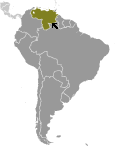World Atlas: Venezuela. On this page you can see the map, country flag and many detailed information about the people, history and economy of Venezuela.

Here you can find online selected information about the geography, inhabitants, government, economy and history of Venezuela. Included are selected statistics, an overview map and the detailed map of Venezuela. But let's start with the flag of Venezuela here:
Venezuela - Overview:
What you should know about Venezuela? Let's start with this: Venezuela was one of three countries that emerged from the collapse of Gran Colombia in 1830 (the others being Ecuador and New Granada, which became Colombia). For most of the first half of the 20th century, Venezuela was ruled by generally benevolent military strongmen who promoted the oil industry and allowed for some social reforms. Democratically elected governments have held sway since 1959. Under Hugo Chavez, president from 1999 to 2013, and his hand-picked successor, President Nicolas Maduro, the executive branch has exercised increasingly authoritarian control over other branches of government. At the same time, democratic institutions have deteriorated, freedoms of expression and the press have been curtailed, and political polarization has grown. The ruling party's economic policies have expanded the state's role in the economy through expropriations of major enterprises, strict currency exchange and price controls that discourage private sector investment and production, and overdependence on the petroleum industry for revenues, among others. Current concerns include: human rights abuses, rampant violent crime, high inflation, and widespread shortages of basic consumer goods, medicine, and medical supplies.
Geography of Venezuela
 Where on the globe is Venezuela? The location of this country is Northern South America, bordering the Caribbean Sea and the North Atlantic Ocean, between Colombia and Guyana. Total area of Venezuela is 912,050 sq km, of which 882,050 sq km is land. So this is quite a large country. How could we describe the terrain of the country? This way: Andes Mountains and Maracaibo Lowlands in northwest; central plains (llanos); Guiana Highlands in southeast. The lowest point of Venezuela is Caribbean Sea 0 m, the highest point Pico Bolivar 4,978 m. And the climate is tropical; hot, humid; more moderate in highlands.
Where on the globe is Venezuela? The location of this country is Northern South America, bordering the Caribbean Sea and the North Atlantic Ocean, between Colombia and Guyana. Total area of Venezuela is 912,050 sq km, of which 882,050 sq km is land. So this is quite a large country. How could we describe the terrain of the country? This way: Andes Mountains and Maracaibo Lowlands in northwest; central plains (llanos); Guiana Highlands in southeast. The lowest point of Venezuela is Caribbean Sea 0 m, the highest point Pico Bolivar 4,978 m. And the climate is tropical; hot, humid; more moderate in highlands.
Inhabitants of Venezuela
Let's take a look how many people live in Venezuela. The number is: 31,304,016 (July 2017 est.). So quite a lot people live here. Who lives here? Spanish, Italian, Portuguese, Arab, German, African, indigenous people. What are the languages in Venezuela? Spanish (official), numerous indigenous dialects. And the religions: nominally Roman Catholic 96%, Protestant 2%, other 2%. How old are the people in average? 28.3 years. We have to add that this number is the median - so one half of the people is older than this, one half is younger. And what is their life expectancy (at birth)? This: 76 years. Where the people live in Venezuela? Here: most of the population is concentrated in the northern and western highlands along an eastern spur at the northern end of the Andes, an area that includes the capital of Caracas. The major urban areas of Venezuela are: Caracas (capital) 2.916 million; Maracaibo 2.196 million; Valencia 1.734 million; Maracay 1.166 million; Barquisimeto 1.039 million (2015).
Government and Economy of Venezuela
The capital of Venezuela is Caracas and the government type federal presidential republic. Let's take a look at the administrative divisions - 23 states (estados, singular - estado), 1 capital district (distrito capital), and 1 federal dependency (dependencia federal); Amazonas, Anzoategui, Apure, Aragua, Barinas, Bolivar, Carabobo, Cojedes, Delta Amacuro, Dependencias Federales (Federal Dependencies), Distrito Capital (Capital District), Falcon, Guarico, Lara, Merida, Miranda, Monagas, Nueva Esparta, Portuguesa, Sucre, Tachira, Trujillo, Vargas, Yaracuy, Zulia. Regarding the economy of Venezuela, important industrial products are agricultural products, livestock, raw materials, machinery and equipment, transport equipment, construction materials, medical equipment, pharmaceuticals, chemicals, iron and steel products, crude oil and petroleum products. Important agricultural products are corn, sorghum, sugarcane, rice, bananas, vegetables, coffee; beef, pork, milk, eggs; fish. The most important export commodities are petroleum and petroleum products, bauxite and aluminum, minerals, chemicals, agricultural products and the most important export partners are US 35.1%, India 17.2%, China 14.1%, Netherlands Antilles 8%, Singapore 5.3%, Cuba 4.1% (2016). The most important import commodities are agricultural products, livestock, raw materials, machinery and equipment, transport equipment, construction materials, medical equipment, petroleum products, pharmaceuticals, chemicals, iron and steel products and the most important import partners are US 22.1%, China 14.3%, Brazil 7.4%, Colombia 4.2% (2016). How rich is Venezuela and how rich are people in this country? The most important number here is GDP per capita (PPP): $12,400 (2017 est.). This is quite good. Let's add that this means Gross Domestic Product per person, which is recalculated with respect to the relative cost of local goods and services. And one more important number - population below poverty line: 19.7% (2015 est.).